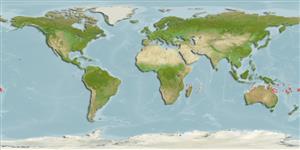Classification / Names
Common names from other countries
Main reference
Size / Weight / Age
Max length : 13.0 cm TL male/unsexed; (Ref. 4343); 10.7 cm SL (female)
Length at first maturity
Lm 4.1, range 4 - ? cm
Environment
Marine; freshwater; brackish; demersal; amphidromous (Ref. 48660); depth range 0 - 5 m (Ref. 86942)
Climate / Range
Tropical, preferred ?; 11°S - 21°S
Distribution
Indo-Pacific: Comoros Islands (East Africa) to Australs Island (French Polynesia) (Ref. 77107). In the Indian Ocean, from Comoros to Mascarene Is. and in the Pacific Ocean, from Japan to French Polynesia, New-Caledonia and Vanuatu (Ref. 87781).
Countries | FAO areas | Ecosystems | Occurrences | Introductions
Short description
Dorsal
spines
(total): 6 - 7;
Dorsal
soft rays
(total): 9-10;
Anal
spines: 1;
Anal
soft rays: 10. Usually 11 unsegmented rays in second dorsal fin. Pectoral rays usually 19. Predorsal midline usually with 13-16 cycloid scales, anterior scales smaller than those posteriorly. Scales on flanks same size as those on caudal peduncle. Belly always with fairly large cycloid scales, about the same size as those on the caudal peduncle. Caudal fin with blackish or dusky horseshoe-shaped band close to margin, medial rays blackish or dusky (Ref. 37578).
IUCN Red List Status (Ref. 115185)
Threat to humans
Harmless
Human uses
Fisheries: commercial
More information
ReferencesAquacultureAquaculture profileStrainsGeneticsAllele frequenciesHeritabilityDiseasesProcessingMass conversion
Tools
Special reports
Download XML
Internet sources
Estimates of some properties based on models
Phylogenetic diversity index
PD50 = 0.5000 many relatives (e.g. carps) 0.5 - 2.0 few relatives (e.g. lungfishes)
Trophic Level
2.8 ±0.31 se; Based on food items.
Resilience
High, minimum population doubling time less than 15 months (Preliminary K or Fecundity.)
Vulnerability
Low vulnerability (25 of 100)
Price category
